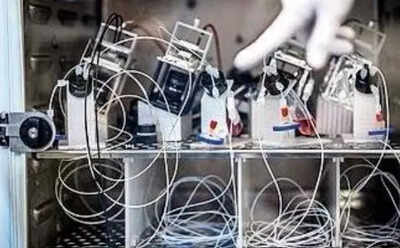ARTICLE AD BOX

Inside a lab in the picturesque Swiss town of Vevey, a scientist gives tiny clumps of human brain cells the nutrient-rich fluid they need to stay alive. It is vital these mini-brains remain healthy, because they are serving as rudimentary computer processors –– and unlike your laptop, once they die, they cannot be rebooted.This new field of research, called biocomputing or “wetware”, aims to harness the evolutionarily honed yet still mysterious computing power of the human brain.At the Swiss start-up FinalSpark’s lab, co-founder Fred Jordan says he believes that processors using brain cells will one day replace the chips powering the artificial intelligence boom.The supercomputers behind AI tools like ChatGPT currently use silicon semiconductors to simulate the neurons and networks of the human brain.
“Instead of trying to mimic, let’s use the real thing,” Jordan said.Among other potential advantages, biocomputing could help address the skyrocketing energy demands of AI, which have already threatened climate emissions targets and led some tech giants to resort to nuclear power.“Biological neurons are one million times more energy efficient than artificial neurons,” Jordan said. They can also be endlessly reproduced in the lab, unlike the massively in-demand AI chips made by companies like behemoth Nvidia.
But for now, wetware’s computing power is a very long way from competing with the hardware that runs the world.To make its “bioprocessors,” FinalSpark first purchases stem cells. These cells, which were originally human skin cells from anonymous human donors, can become any cell in the body.FinalSpark’s scientists then turn them into neurons, which are collected into millimetre-wide clumps called brain organoids.
They are around the size of the brain of a fruit fly larvae, Jordan said. Electrodes are attached to the organoids in the lab, which allow the scientists to “spy on their internal discussion,” he explained.The scientists can also stimulate the organoids with a small electric current. Whether they respond with a spike in activity –– or not ––is roughly the equivalent of the ones or zeroes in traditional computing. Ten universities around the world are conducting experiments using FinalSpark’s organoids –– the small company’s website even has a live feed of the neurons at work.Benjamin Ward-Cherrier, a researcher at the University of Bristol, used one of the organoids as the brain of a simple robot that managed to distinguish between different braille letters.There are many challenges, including encoding the data in a way the organoid might understand –– then trying to interpret what the brain cells “spit out,” he said.“Working with robots is very easy by comparison,” Ward-Cherrier said with a laugh. “There’s also the fact that they are living cells –– and that means that they do die,” he added.

 7 hours ago
4
7 hours ago
4









 English (US) ·
English (US) ·